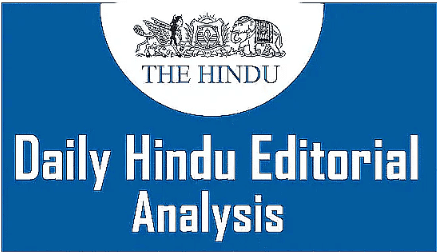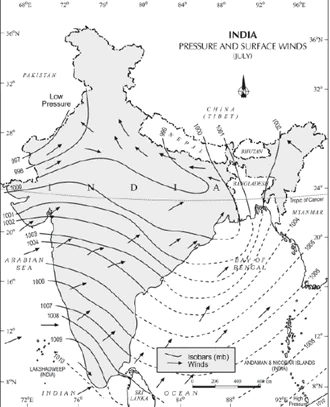UPSC Exam > UPSC Notes > Current Affairs & Hindu Analysis: Daily, Weekly & Monthly > The Hindu Editorial Analysis- 5th October 2024
The Hindu Editorial Analysis- 5th October 2024 | Current Affairs & Hindu Analysis: Daily, Weekly & Monthly - UPSC PDF Download

The Other Monsoon
Why in News?
India’s southwest monsoon has ended on an optimistic note, with 8% more rain than anticipated. Reassuringly, the rainfall forecast by the India Meteorological Department (IMD), particularly since July, was accurate. Monsoon clouds continue to prevail over the country but given the centrality of rainfall to the Indian economy, focus has already shifted to the ‘other monsoon’, the northeast monsoon.
Southwest Monsoon: Lifeline of India’s Climate and Agriculture:
- The southwest monsoon season is an important weather event in the Indian subcontinent.
- This season is marked by the arrival of winds that carry moisture from the Indian Ocean.
- The monsoon typically begins in June and ends in September.
- This annual weather pattern significantly affects the climate of the region.
- It has a major impact on agriculture, water resources, and the livelihoods of the people.
- The southwest monsoon delivers widespread rainfall, which is essential for maintaining ecosystems.
- This rainfall also supports the farming economies in countries like India.
Southwest Monsoon: Birth, Journey, and Impact on India:
- Genesis of the Southwest Monsoon: The start of seasonal winds occurs in May when the low-pressure areas over the northwestern plains of India become strong enough to draw in the southeast trade winds from the Southern Hemisphere.
- Moisture-Laden Winds: These winds come from the Indian Ocean and carry moisture due to the warm equatorial currents.
- Southwest Monsoons: As these winds cross the equator, they change direction to a southwesterly path, which is why they are called "southwest monsoons."

What Defines the Southwest Monsoons Arrival?
- Abrupt Monsoon Onset: The start of the rainy season during the southwest monsoon is characterized by a sudden and sharp beginning.
- Monsoon Burst with Thunder and Lightning: This quick arrival of moisture-laden winds, which comes with strong thunder and lightning, is known as the "burst" of the monsoons.
- Regional Variation in Onset: Coastal regions such as Kerala, Karnataka, Goa, and Maharashtra usually experience this burst in the first week of June, while areas further inland may see it by the first week of July.
- Temperature Drop: A noticeable decrease in daytime temperatures, ranging from 5°C to 8°C, is typically recorded between mid-June and mid-July.
Monsoon Branches: Journey via the Arabian Sea and Bay of Bengal Branches
- The incoming monsoon winds are split by India's landscape and a low-pressure area in northwestern India into two main branches:
- Arabian Sea branch
- Bay of Bengal branch
- Monsoon Tales: Arabian Sea Winds, Western Ghats, and Rain-shadow Wonders
- The monsoon winds from the Arabian Sea divide into three branches:
- Western Ghats and Rain-shadow Effect:
- The winds rise as they hit the Western Ghats, which cools them down.
- This leads to heavy rainfall (between 250 cm and 400 cm) on the windward side of the Sahyadris (Coastal Maharashtra) and the Western Coastal Plain.
- After crossing the Ghats, the winds descend, warm up, and lose moisture, resulting in little rain on the eastern side, creating a rain-shadow area.
- Places like Kozhikode, Mangalore, Pune, and Bengaluru show notable differences in rainfall.
- Central India’s Monsoon Impact:
- Another branch of the Arabian Sea monsoon affects the area north of Mumbai.
- This branch travels through the Narmada and Tapi river valleys, bringing rain to central India.
- The Chotanagpur plateau receives about 15 cm of rainfall from this branch.
- Eventually, these winds reach the Ganga plains and mix with the Bay of Bengal monsoon winds.
- Himalayan Rainfall Ballet:
- The third branch affects the Saurashtra Peninsula and Kachchh, moving over western Rajasthan and along the Aravallis.
- This results in limited rainfall in these areas.
- The winds continue to Punjab and Haryana, where they combine with the Bay of Bengal branch, bringing rain to the western Himalayas.
- Western Ghats and Rain-shadow Effect:
- The monsoon winds from the Arabian Sea divide into three branches:
- Bay of Bengal Ballet:
- The Bay of Bengal monsoon winds first reach the coast of Myanmar and parts of southeastern Bangladesh.
- However, due to the Arakan Hills along Myanmar's coast, much of this branch is redirected towards India.
- This means the monsoon enters West Bengal and Bangladesh from the south and southeast, instead of the usual southwest direction.
- Under the influence of the Himalayas and the low pressure in northwest India, this branch splits into two main streams:
- One stream moves west along the Ganga plains to the Punjab plains.
- The other goes north through the Brahmaputra valley, bringing heavy rain to the north and northeast.
- A smaller branch of the Bay of Bengal monsoon reaches the Garo and Khasi hills in Meghalaya.
- Mawsynram, located on the Khasi Hills, is known for having the highest average annual rainfall in the world.
Retreating Southwest Monsoon Season: October-November Transition
- Transition to Autumnin October-November:
- In October and November, the sun appears to move southward.
- The low-pressure area over the northern plains, known as the monsoon trough, starts to weaken.
- This weakening is gradually replaced by a high-pressure system.
- These months signify the retreat of the monsoon season.
- Retreat of the Monsoon to Southern Indiafrom Western Rajasthan:
- By the end of September, the southwest monsoon begins to fade.
- This change happens as the low-pressure trough shifts southward from the Ganga plain.
- The monsoon starts to withdraw from western Rajasthan in early September.
- By the end of September, it leaves regions such as Rajasthan, Gujarat, and the Western Ganga plain.
- By early November, the effects of this low-pressure system reach Karnataka and Tamil Nadu.
- By mid-December, the monsoon completely exits the southern Peninsula.
- October Heat and Cool Nights:
- October and November represent a shift from the hot, rainy season to dry winter weather.
- Daytime temperatures remain high, while nights become cool and pleasant.
- The soil remains moist during this transition.
- Due to high temperatures and humidity, daytime weather can feel quite uncomfortable, often referred to as “October heat”.
- In the latter part of October, northern India experiences a quick drop in temperatures.
- By late October, northern India remains dry, while the eastern regions of the Peninsula may still receive rain.
- Cyclonic Influences:
- The low-pressure conditions over northwestern India shift to the Bay of Bengal by early November.
- This movement leads to cyclonic depressions forming in the Andaman Sea.
- These cyclones, particularly strong when they cross the eastern coast of southern India, can cause significant damage to river deltas like the Godavari, Krishna, and Kaveri.
- While these storms also affect West Bengal, Bangladesh, and Myanmar, they are less common in the Arabian Sea.
- The Coromandel coast mainly receives rainfall from these cyclonic events.
The document The Hindu Editorial Analysis- 5th October 2024 | Current Affairs & Hindu Analysis: Daily, Weekly & Monthly - UPSC is a part of the UPSC Course Current Affairs & Hindu Analysis: Daily, Weekly & Monthly.
All you need of UPSC at this link: UPSC
|
63 videos|5408 docs|1146 tests
|
Related Searches





















